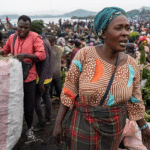Nicole Hsu
Have you ever heard about the conflicts in Palestine, Ukraine, or Syria? I bet you have because these countries dominate the news headlines every day. But beneath these dominating global headlines lies another humanitarian catastrophe that has been going on for decades yet receives barely any attention—the genocide in the Democratic Republic of the Congo.
The history of the Congo genocide
Before we talk about the impacts and consequences of the Congo Genocide, it is important first to understand the historical context that fueled this conflict.
DRC sits on a goldmine—literally. Beneath the lands of DRC lies an abundance of minerals like coltan, cobalt, gold, and anything that covers the production of smartphones to cars. However, the abundance of materials did not bring them prosperity, instead, it contributed to national instability and suffering.
We can blame the nation’s decline mainly on two factors: Foreign and domestic. Foreign governments and mass corporations all saw the DRC as a brand-new opportunity to attain mass wealth, while armed militias also wanted total control over the people, as they saw that taking over this region wouldn’t just give them wealth, but power and influence. All of these were not only exacerbating the already dire situation but also making future conflicts more and more possible. Systematic corruption also exists, and greedy politicians and corrupted presidents all significantly worsened the crisis. While the rich in DRC amassed great wealth from the trades and mineral mining, the Congolese people are living in violence, starvation, and danger. The Congolese government has failed its people.
With groups of people killing each other for food, children forced to plow the fields every single day, and adults dying of diseases and starvation every second, even international peace-keeping efforts have been useless. The death of millions and the mourning of more have given this long-lasting, but never-ending conflict a name: the Congo genocide.
The consequences
There is a reason why this conflict isn’t known as the Congo Civil War or the Congo Conflict, but the Congo Genocide – because of the mass killings of civilians.
Over 5.4 million people have died as a direct or indirect result of the conflicts, making it one of the deadliest wars since World War II. Moreover, a total amount of 10 million civilians have been misplaced, whether it is for fleeing a war-struck country or kidnapped and forced to do labor.
Perhaps the most terrifying consequence is the absolute horror of what people have done to the most vulnerable group of all – children. In Congo, children don’t go to school or play with their friends, instead, they are often forcefully recruited into the army or raped by gangs and government officials.
-
Child Soldiers: Between 5,000 and 10,000 children have been recruited by armed groups to fight, forced into combat roles they never chose
-
Sexual Violence as a Weapon of War: In the eastern DRC, reports confirm that dozens of children have been raped by armed militias just in the past year. Sexual violence has become a tool of terror, leaving tens of thousands of victims physically and emotionally scarred.
-
Lack of Education: Schools have been destroyed, and in many conflict zones, children are left with no access to education. With no alternative, many are forced into labor or trafficked, stripping away normal childhoods.
An Urgent Crisis Ignored by the World.
Despite the utter suffering, imaginable torture, and horrid crimes done in DRC, the world barely batted an eye. Little to no news source reports about this humanitarian crisis, and even if some do, nobody pays attention.
Am I saying that people and the news should stop talking about Palestine and Ukraine, and only talk about the Congo Genocide? Of course not. But should they start to introduce this crisis to people and help the victims gain recognition and help? Most definitely.



